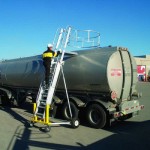Which specific OSHA regulations apply to fall protection for our drivers and other employees climbing onto trucks and flatbed trailers to strap and secure loads?
 Several OSHA regulations can and do apply to fall protection for trailers and trucks; however, one specific regulation is broad and encompasses a wide range of applications and instances. It is this particular “gotcha” regulation where emphasis could be applied to trucks and trailers. OSHA 1926.501(b)(1) states:
Several OSHA regulations can and do apply to fall protection for trailers and trucks; however, one specific regulation is broad and encompasses a wide range of applications and instances. It is this particular “gotcha” regulation where emphasis could be applied to trucks and trailers. OSHA 1926.501(b)(1) states:
- “Unprotected sides and edges.” Each employee on a walking/working surface (horizontal and vertical surface) with an unprotected side or edge which is 6 feet (1.8 m) or more above a lower level shall be protected from falling by the use of guardrail systems, safety net systems, or personal fall arrest systems.”
As you can see from the language, this rule is intended to apply to any working or walking surface that employees might be using to conduct their job. This most certainly is intended to include flatbed trucks and trailers, as one must use these surfaces in order to conduct their job each day.
OSHA has since updated their interpretation from 2004 and omitted trailers and vehicles from the relevant regulation. So, in short, when loading and unloading trailers within 6′ of the next surface, fall protection is needed. If your drivers are working at a general industry site, that number becomes 4′.
As far as the various solutions available, there certainly are many more options today than even 10 years ago, all designed to combat this very hazardous scenario that occurs on a daily basis in the transportation industry. This includes a few fixed systems, such as rigid track lifelines, as well as temporary systems that can be used for an active fall arrest system. There also are a few temporary guardrail systems, which are designed to pack up tightly and can be used and set up in little time to help workers meet the OSHA standard. We at FallProof Systems have dedicated an entire blog post to your industry, which discusses these solutions in depth.
View All FAQs.
1 OSHA 1926.501(b)(1)

